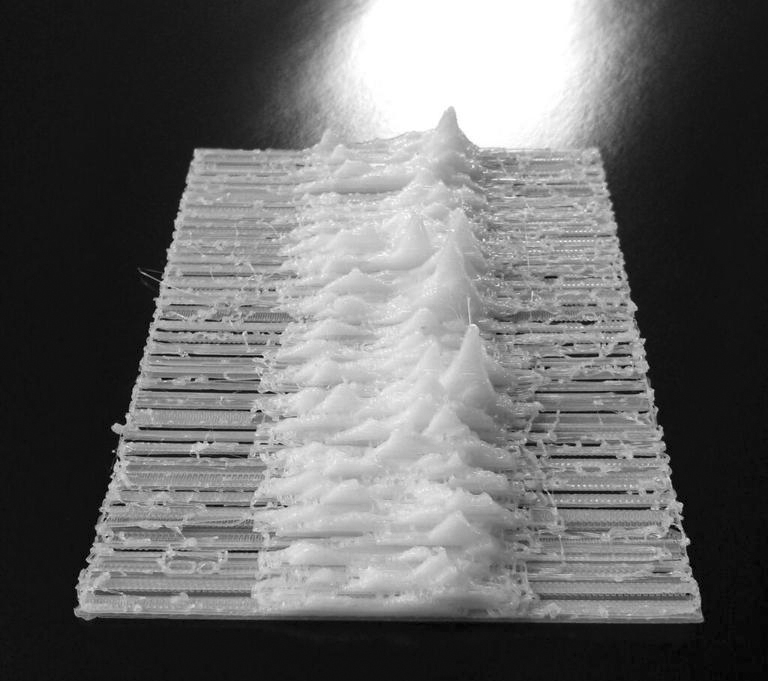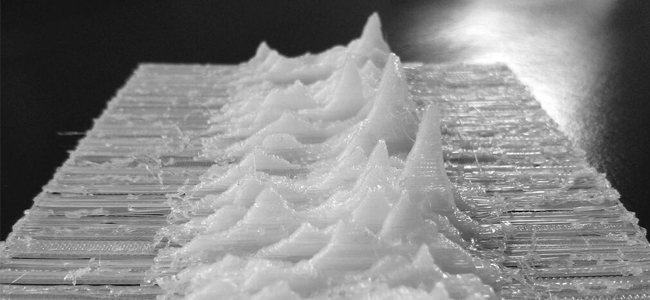The advances in 3D printing technology has already done some certifiably cool stuff for music fans. We’ve already seen some customisable, fully-functioning guitars and the world’s first 3D printed records demonstrating the exciting possibilities of what the new manufacturing technology can achieve.
Now an enterprising DIY fan has opened another exciting potential for 3D Printing: album artwork.
German blogger Michael Zoellner has been experimenting with 3D printing for some time and after being inspired by Grant Gee’s 2007 documentary on Joy Division, Zoellner decided – as he writes in an entry on his website – “I have to print the iconic cover of their first album Unknown Pleasures in 3D.”
Factory Records designer Peter Saville designed the art for the 1978 album, and his sleeve – based on an image of radio waves from a pulsar CP 1919 – became as instantly recognisable as the moody post-punk musical contents contained within it. But despite his admirable ambitions to create a physical version of Saville’s cover, Zoellner writes “unfortunately I could not find a single vector graphic or 3D model anywhere.”
“There are articles about the history of the graphics, Peter Saville’s artwork and PSR B1919+21,” writes Zoellner, “I even tried to visualize PSR B1919+21‘s waveforms. But in the end I spend an evening tracing the waves by hand.” The German then painstakingly turned his drawings into lines of code to make a printable model of the 3D vector graphic drawing, then uploaded his efforts as a printable file on crowd manufacturing site Thingiverse.
Like the other working prototypes that have sprung up in recent months, the 3D printed model of the Joy Division artwork was created through a process of additive manufacturing, layering very fine sheets of plastic resin or polycarbon from the ground up, rather than traditional subtractive processes that cut, shape, or refine material.
Of couse if you want to make your very own Unknown Pleasures model you’re still looking at a very expensive investment in getting a 3D printer big enough and with enough resolution to print such an object, with ‘in-the-home’ use of 3D printing still a ways off in the future. But Zoellner’s pet project opens an enormous door of possibilities. Imagine printing 3D models of other iconic artwork, but thinking bigger, it could introduce a new evolution in album artwork…
On an immediately practical level, imagine printing 3D models of other iconic artwork (we’ll take a Nevermind and Dark Side Of The Moon thanks), but thinking bigger, it could introduce a new evolution in album artwork, a welcome change considering that the digital revolution seems to have slowly shrunk down artist’s ambitions and designs – both literally and figuratively. Iconic album covers now typically seen as a few square centimetres in the iTunes library or on an mp3 player’s screen.
Interestingly, Joy Division also provided inspiration to another innovator in 3D Printing, namely Instructables researcher and DIY project maker Amanda Ghassaei, who in her experiments hit upon a way to turn any mp3 into a 3D printed record, using the Manchester group’s songs ‘Disorder’ and ‘Love Will Tear Us Apart’ to demonstrate the new technique.
In theory however, printing off your very own copy of a Joy Division song, or even Peter Saville’s iconic Unknown Pleasures artwork, brings about some sticky issues regarding copyright and music piracy. While 3D printing isn’t a widely available or affordable medium, the hope is that it one day will be, and considering designs are as easy as sharing on instructional websites – like Instructables and Thingiverse – it’s a very fine line between community based content and popular torrenting websites like The Pirate Bay.
As a recent report from TechCrunch demonstrates, concerns over peer-to-peer networks for shared ‘physibles’ – the digital designs for 3D printed objects – are already emerging online in greater numbers, demonstrating a new wave that echoes that of Napster and the mp3 boom in the late 90s, except this time it would be through the sharing of real-world physical objects and designs. But let the legal eagles figure that one out, for now, the prospect of more music-related 3D Printing innovations is enough reason to get excited.

































